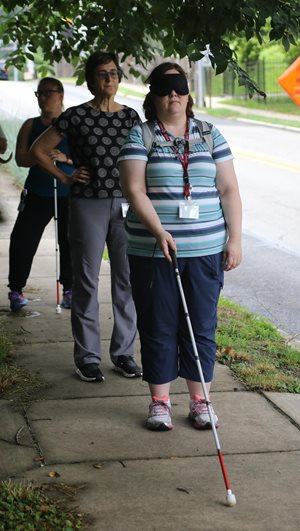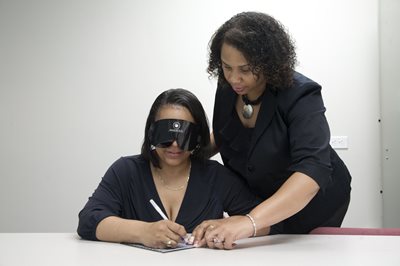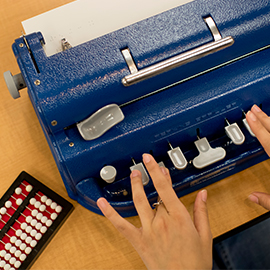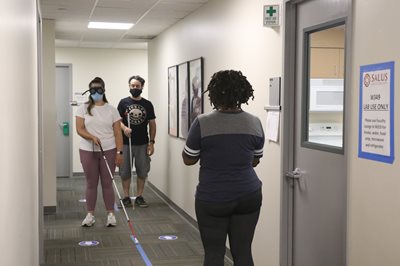In this podcast, Blindness and Low Vision Studies (BLVS) alumni Katelyn (Kate) Maffei, MEd ‘21, TVI, VRT, and Kinshasa Coghill, MS ‘02, CLVT, CVRT, OMS, and Carolyn Pijanowski, '24VRT, '24O&M, share what a day in the life of a BLVS professional looks like in addition to giving a sneak peak into Salus University’s programs.
Maffei: What does a day in your life as a BLVS professional look like?
 Coghill: I am a low vision therapist (LVT) vision rehabilitation therapist (VRT), and an orientation and mobility (O&M) specialist. Every day is a different day, but for the most part, this is how I start my day. I believe in work-life balance, so it is important for me to get up, do some movement, meditate, hydrate, eat a good meal, and then prepare for my day. Typically, I'm seeing between two to three participants or learners, depending on what their goals are. Lesson planning is also part of my morning, so I look at:
Coghill: I am a low vision therapist (LVT) vision rehabilitation therapist (VRT), and an orientation and mobility (O&M) specialist. Every day is a different day, but for the most part, this is how I start my day. I believe in work-life balance, so it is important for me to get up, do some movement, meditate, hydrate, eat a good meal, and then prepare for my day. Typically, I'm seeing between two to three participants or learners, depending on what their goals are. Lesson planning is also part of my morning, so I look at:
That's the day in the life, making sure that I'm well prepared for what the learner will need, looking at their objectives, looking at how I'm going to introduce those objectives, how I'm going to understand that they have grasped the concepts and what they're going to demonstrate and making sure that I have the tools and resources that are a part of that lesson.
Maffei: My day in life is a little different because I am not an itinerant service provider, so I'm not going from place to place. I stay in one place for the majority of my day. I am a teacher of students with visual impairments (TVI) at a School for the Blind. I have my kids in my class that I'm with all day every day. [They are the] best kids in the world. I get to do all different things with them, like their schedules and different tactile arts and crafts, and I start every day with our affirmations. I enjoy spending time with my kids. I'm also always talking with families. I have different meetings that I'm a part of, different documents that I'm contributing to, braille, all kinds of stuff.
There's so much that a TVI does during the day. I also work with some early intervention clients. So after my day at the school for the blind, then I get a little taste of the itinerant life where I'll drive to some of my kids' houses. Other kids I'll meet at the library, or I'll see them at the playground. I work with birth to three [years old] with my early intervention kids. Much of my early intervention day in the life is talking to families and parents, finding out what's our next step, what's our next goal, what's our next milestone, and working to figure out how we can incorporate different skills for that kid at that age.
As far as my self-care, I go to pilates, I do yoga and I try to drink a lot of water throughout the day. Kinshasa and I are both working as professionals in the BLVS field, but Carolyn's a little different, as you're currently a student at Salus. What does a day in your life look like, Carolyn?
 Pijanowski: This semester is my final VRT semester, so I'm doing my internship right now. I'm interning at the Bureau of Blindness and Visual Services in Harrisburg, Pennsylvania. So I drive there, but we are itinerant, so I am traveling to people's homes. I have four to five clients that I see each day, visiting with them and coming up with goals or lessons that we are doing together. In between clients, I'm drinking a lot of water and taking little breaks.
Pijanowski: This semester is my final VRT semester, so I'm doing my internship right now. I'm interning at the Bureau of Blindness and Visual Services in Harrisburg, Pennsylvania. So I drive there, but we are itinerant, so I am traveling to people's homes. I have four to five clients that I see each day, visiting with them and coming up with goals or lessons that we are doing together. In between clients, I'm drinking a lot of water and taking little breaks.
Then I come home, and since I am also taking O&M classes I have schoolwork. At the end of the night, I make myself dinner and watch a movie or TV show to unwind. [My schedule is] busy, but it's really good. I like going out and seeing different clients. I saw a two-and-a-half-year-old the other week, and I've seen a 98-year-old. So it's a wide range of ages, which I like because of the different strategies and teaching moments involved.
Maffei: What do you like about the field and what do you like about attending Salus?
Pijanowski: I like Salus because it is an online program for the most part, so it is very flexible. If my schedule is packed with clients and I'm not getting home until late on Monday, I can wait, maybe do some readings on Monday night, but then on Tuesday, I can get into the discussion board posts. There are weekly assignments, so students are always on pace, but it's nice that you can still go at your own pace throughout the week.
The professors are very nice and easy to reach out to and say, “Hey, I'm not understanding this. Can you explain more?” They're very flexible with students. They know we're busy (because we are practitioners). They're busy. Everyone's busy in this field, so they get it. It's nice to have that support.
During the summer I also have classes that we attend in person at the University’s Elkins Park, Pennsylvania campus. I like [this structure] because it's a chance to get to know the other students who are in the classes with you outside of the computer screen. After my summer classes, I wasn't afraid to text my classmates when I had a question. You all get closer and you get your hands-on experience. You get to go to the Activities of Daily Living (ADL) lab and practice O&M skills. You're learning these skills in person, which I appreciate because I am a very hands-on person.
Coghill: Carolyn, how was applying to the program?
 Pijanowski: I wrote an essay on why I wanted to get into the [BLVS] field. Each of the program directors discussed each field with me because I did not know much coming into [the program]. They explained what O&M, VRT, TVI, and Low Vision Rehabilitation (LVR) do. When I met with them they were super supportive about helping me and breaking [the application process] down step-by-step. It was really easy and I heard back from them with a decision very quickly.
Pijanowski: I wrote an essay on why I wanted to get into the [BLVS] field. Each of the program directors discussed each field with me because I did not know much coming into [the program]. They explained what O&M, VRT, TVI, and Low Vision Rehabilitation (LVR) do. When I met with them they were super supportive about helping me and breaking [the application process] down step-by-step. It was really easy and I heard back from them with a decision very quickly.
Coghill: So, you felt like you got a lot of support from them?
Pijanowski: Yeah, and I know some other students, not me, started in the VRT program and then switched to TVI. All of the professors work together to make the switch possible. It is very easy. In the beginning, you take a lot of the same classes and then if you want to change [your program] later it's easier to transition to a different role if you feel like one fits you better. Everyone was super supportive and nice and it was nice getting to know them before classes started, too.
Coghill: You're going to get a master's and you're adding on a certificate? That's the cool part about Salus University, you can get a master's degree, but you can add on other certificates. Can you talk more about that?
Pijanowski: I don't think a lot of schools offer this option. I'm getting a master's in VRT, and then I'm also doing a certificate in O&M. Throughout my time here, I've been taking classes for both VRT and O&M, building up to both the master's and certificate, which is nice because now I get to go out in the field and I get an even wider scope of practice, which I appreciate.
Coghill: I like that you said you can widen your scope of practice. That's a real benefit of attending Salus. Is there anything else you would like to share about your experience at Salus University?
Pijanowski: I got to explore Philly a little bit, so that was great. I know when I started, when I was learning about the BLVS fields, someone recommended to me that I shadow a professional to see what a day is like in their shoes, and that could help me make a decision. I enjoyed it. I recommend that any student looking into joining these programs contact current professionals to shadow and to see what a day is like.
What are your recommendations for finding these professionals out in the field in your area to contact them and call them up [for shadowing opportunities]?
 Coghill: The Academy of Certification of Vision Rehabilitation Professionals is the certifying body for blindness and low vision professionals. They have a website and I recommend to browse their website. On their website, there is a verification of certification. What that means is you can select what certified professional you want, and you can select the state or province. It will bring you to a directory that will show you all the certificates in your area, whether they're active, and the expiration date.
Coghill: The Academy of Certification of Vision Rehabilitation Professionals is the certifying body for blindness and low vision professionals. They have a website and I recommend to browse their website. On their website, there is a verification of certification. What that means is you can select what certified professional you want, and you can select the state or province. It will bring you to a directory that will show you all the certificates in your area, whether they're active, and the expiration date.
You can then cross-reference with LinkedIn. You could look at BLVS professional agencies in the neighborhood. Just put that in the Google search. That's the way to find out who is certified and how you can shadow someone.
Pijanowski: When I first started, I was cold calling Veterans Affairs centers saying “Hey, you have a vision rehab therapist, can I come over?” Kate, what about you? What do you recommend for TVIs?
Maffei: It's a little different for TVIs. I would recommend seeing if there is a school for the blind near you, because if you find a school for the blind you're going to find a lot of TVIs. Another option is, if you're not close to a school for the blind, you can always look into an Intermediate Unit (IU). An IU provides related service providers to schools. For example a speech therapist, occupational therapist, a teacher of the hearing impaired, things of that nature. The IUs also have TVIs.
If you look up what IU is near you, call that IU and say, “Hey, do you have any TVIs on staff that would be willing to take someone to shadow?” I think it would be easier to get in at a school for the blind, but like I said, there's not a school for the blind everywhere. It’s going to be location-specific.
Pijanowski: What I have found is everyone's so nice in this field that if you call them up and they're like, “Oh, actually, I'm not in this area, but I know so-and-so and can I give her your contact information?” If you ask around, people are excited to get other people into the field, so they're going to ask around for you as well and get all their connections together to help make that work for you.
Maffei: I love that you said that, Carolyn, because that is so true. Being in this field, it's a family of low vision and blindness professionals. We all are so passionate about the community that we're serving, and we just want the best of the best to be in the profession. [Many BLVS professionals] are so willing to have people come and shadow us for a day. Like you said, even if you aren't near us, we probably know someone who is in your area.
Coghill: I want to piggyback on what you are both saying because it is so true. Our field is niche, and because of that, it means there aren't enough professionals currently to meet the needs of 15 million visually impaired individuals. So, this is the opportunity for you to have a flexible learning program with lots of support. We take [people from various] backgrounds, we take undergrads with many different undergraduate degrees. The salaries allow BLVS professionals to be well compensated. Depending on the region you're in, you can still be a healthcare professional. We need professionals.